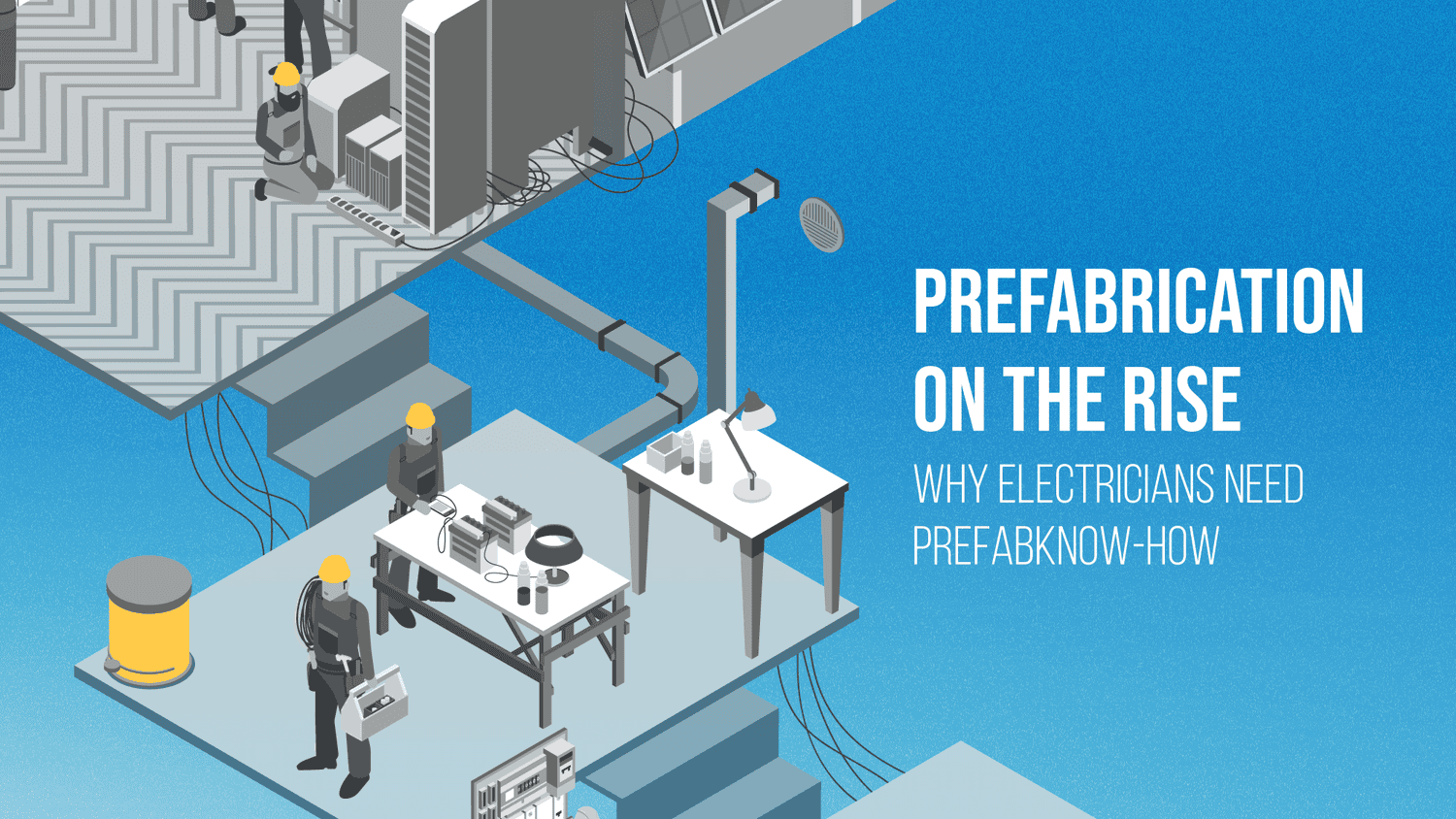Prefabrication, often shortened to prefab, is a construction method where building assemblies or modules are manufactured off-site in a factory or workshop setting, rather than being built on-site. These prefabricated elements can include anything from walls, floors, and ceilings to entire rooms or sections of a building. Once manufactured, these assemblies are transported to the construction site for assembly.
The popularity of prefab in the electrical industry is on the rise because it saves time, improves quality, and increases productivity. With prefab, electrical parts are made in facilities, so they’re ready to go when needed on-site, which speeds up the whole construction process.
Because prefab assemblies are manufactured in controlled environments, they are less likely to contain errors. This eliminates the need for redoing assembled parts, which saves time. Additionally, as people become more environmentally conscious, prefab is considered a more sustainable option because it reduces waste. All these advantages make prefab a popular choice in the electrical industry.
The surge in demand for prefab assemblies makes it essential in the electrical work process. According to Inkwood Research, the prefab construction market is expected to reach $269 billion by 2032, marking a transition towards lean construction practices.
Let’s explore more about how prefab benefits the work process in the construction and electrical sectors.
Benefits of Prefab
Prefab in electrical work offers numerous advantages, including time and cost savings, improved quality control, enhanced safety, and increased productivity, making it an attractive option for construction projects.
- Increased Installation Efficiency: Electrical assemblies are built to exact specifications in a controlled environment. Once delivered to the site, they simply need to be connected to the power source, significantly reducing installation time. This streamlined process minimizes delays and keeps the project on track.
- Optimized labor costs: Prefab allows for repetitive tasks to be completed by less-experienced workers under supervision in a factory setting. This frees up skilled electricians on-site for more complex tasks, leading to more efficient use of labor and potentially lower overall labor costs.
- Improved Quality Control: Factory environments with controlled conditions enable stricter quality control measures compared to on-site electrical work. Prefab assemblies undergo rigorous testing before being shipped, ensuring consistent quality and reducing the risk of errors during installation.
- Reduced Material Waste: Prefab minimizes material waste by using precise measurements and allowing for the recycling of leftover materials in a controlled factory setting. This not only reduces costs but also promotes a more sustainable construction process.
- Less Material Handling: Traditional construction involves moving materials from room to room as electrical components are assembled. Prefab eliminates this need, as most of the work is already completed off-site. This translates to less on-site clutter, improved safety, and a cleaner work environment.
- Mitigated Weather Risks: Electrical work can be significantly impacted by weather conditions. Prefab takes place in a controlled environment, eliminating delays caused by rain, snow, or extreme temperatures. This ensures a more predictable project timeline.
- Reduced Site Disruption: With most of the electrical work happening off-site, prefab minimizes noise, dust, and overall disruption to the construction site. This is particularly beneficial for projects with tight spaces or those requiring continued operation of existing facilities.
- Improved Worker Safety: Prefab reduces the need for electricians to work at heights or in confined spaces on-site. Additionally, factory settings often have stricter safety protocols compared to busy construction sites, leading to a safer work environment.
- Enhanced Project Coordination: Prefab requires close collaboration between the electrical contractor, prefabricator, and other trades involved in the project. This upfront planning leads to better coordination and smoother installation on-site.
- Potential for Cost Savings: While the upfront investment in prefab can be higher, the overall project cost can be reduced through the benefits mentioned above. Reduced labor hours, minimized material waste, and faster completion times can lead to significant cost savings.
How Prefab Impacts Electrical Work
Prefab is shaking things up in the world of electrical work, and it’s not just about speeding things up. While faster project completion is a perk, the real impact goes deeper. Here’s how prefab is transforming the electrical field:
Shifting the Focus:
- From On-site Assembly to Off-site Manufacturing: Traditionally, electricians built most assemblies on-site, juggling tools, materials, and potential weather disruptions. Prefab flips this script. Electrical assemblies like pre-cut wires, mounted boxes, and even pre-wired panels are built inside controlled workshops.
For electrical work, prefab translates to building electrical assemblies off-site. This can involve tasks like:
- Cutting and pre-wiring electrical cables: Imagine having all the electrical wires pre-cut to the exact lengths needed, with connections already made, before they even reach the building site.
- Mounting electrical boxes: These boxes house switches, outlets, and other electrical components. Prefab allows for pre-mounting these boxes onto walls or panels in a workshop setting, saving time on-site.
- Building electrical panels: These panels distribute electricity throughout a building. Prefab allows for assembling and testing electrical panels off-site, ensuring everything is working correctly before installation.
Why Electricians Need Prefab Expertise
Traditional electrical training focuses on on-site construction methods like conduit bending, wire pulling, and fixture installation. Prefabricated systems, on the other hand, require a different skill set. Electricians may need to learn how to interpret prefab schematics, understand pre-assembled components, and master efficient connection techniques.
Electricians need prefab expertise to navigate the evolving landscape of construction practices effectively. Prefab is increasingly becoming a staple in the industry, offering benefits such as enhanced efficiency, improved quality control, and cost savings.
While traditional electricians bring valuable skills to the table, understanding prefabricated electrical systems is becoming an essential skill for the future of electrical construction.
How to Prepare for a Career in Prefabricated Electrical Work
As prefab becomes more widespread, the demand for electricians with expertise in this approach is growing. These “prefab electricians” need a strong understanding of:
- Electrical Codes and Standards: Ensuring all prefabricated assemblies meet safety regulations.
- Electrical Plans: Accurately interpreting blueprints to create the correct prefabricated assemblies.
- Prefab Techniques: Understanding the specific materials and processes used in prefab shops.
Educational and training opportunities for aspiring prefab electricians are essential for developing the skills and knowledge needed to excel in this field. Here are some potential pathways:
- Trade Schools and Vocational Programs: Many trade schools and vocational programs offer specific courses or certifications in electrical work, including prefab techniques. These programs provide hands-on training in electrical systems, blueprint reading, wiring methods, and prefab practices.
- Apprenticeships: Apprenticeships allow aspiring electricians to gain practical experience while learning from experienced professionals. Some apprenticeship programs may specialize in prefab methods, providing valuable on-the-job training and mentorship.
- Continuing Education Courses: Electricians can enhance their skills and knowledge through continuing education courses focused on prefab techniques. These courses may be offered by industry associations, community colleges, or online platforms and cover topics such as prefab design, installation, and quality control.
- Manufacturer Training Programs: Many manufacturers of electrical components offer training programs for electricians on how to use their prefabricated products effectively. These programs typically provide instruction on product specifications, installation best practices, and safety guidelines.
- Certifications: Obtaining relevant certifications can demonstrate proficiency in prefabrication techniques and enhance job prospects. Certifying bodies such as the National Center for Construction Education and Research (NCCER) offer certifications specifically related to prefab and electrical work.
- On-the-Job Training: Working for a company that specializes in prefab or electrical contracting can provide valuable on-the-job training opportunities. Aspiring electricians can learn from experienced colleagues and gain practical experience in prefab methods.
Prefab is here to stay, and it’s fundamentally changing how electrical work is done. It can be a win-win for everyone involved – faster, safer, higher-quality construction with less waste. By embracing prefab and developing the necessary skills, electricians can ensure they remain at the forefront of this evolving construction landscape. To further develop prefab skills electricians can join apprenticeship programs such as:





